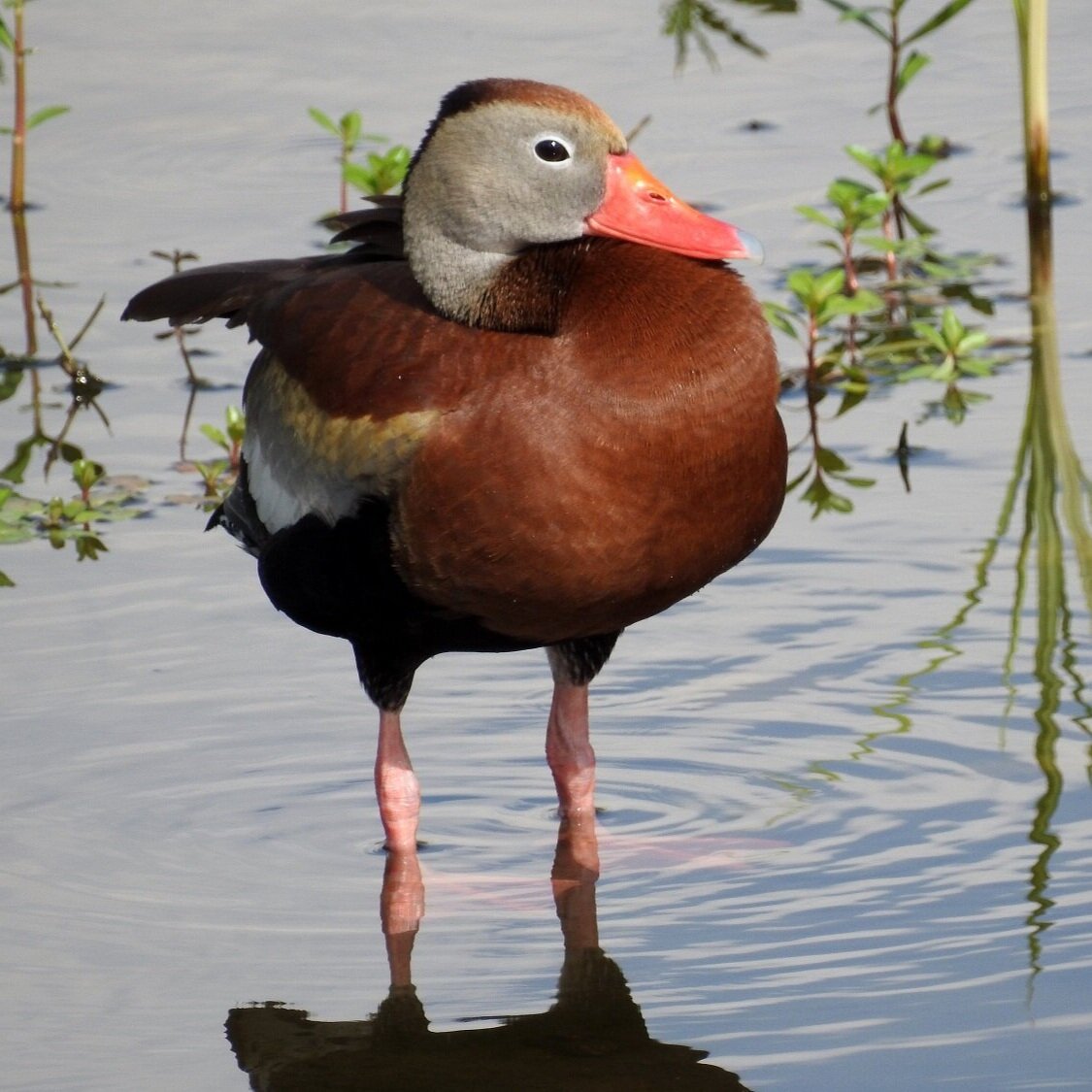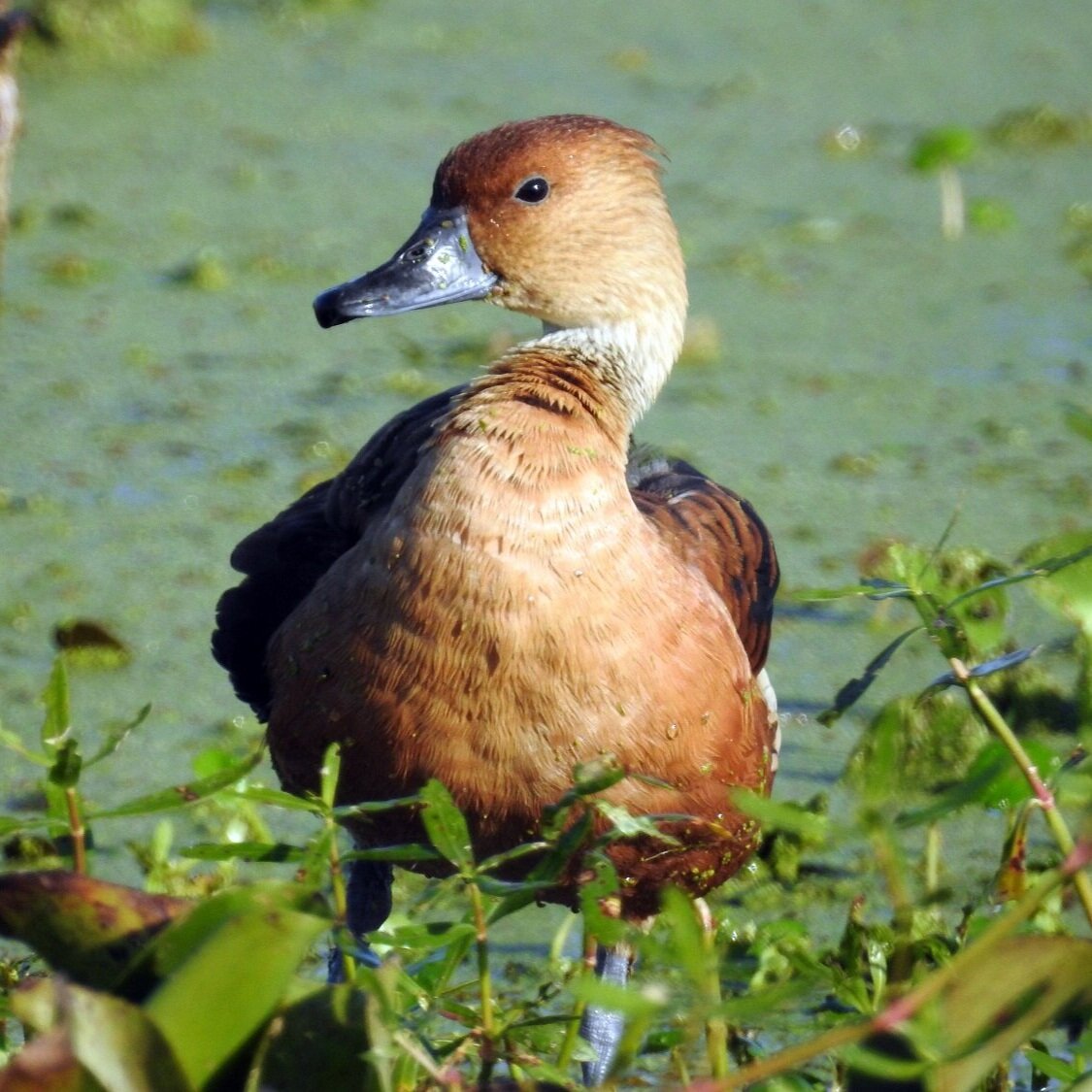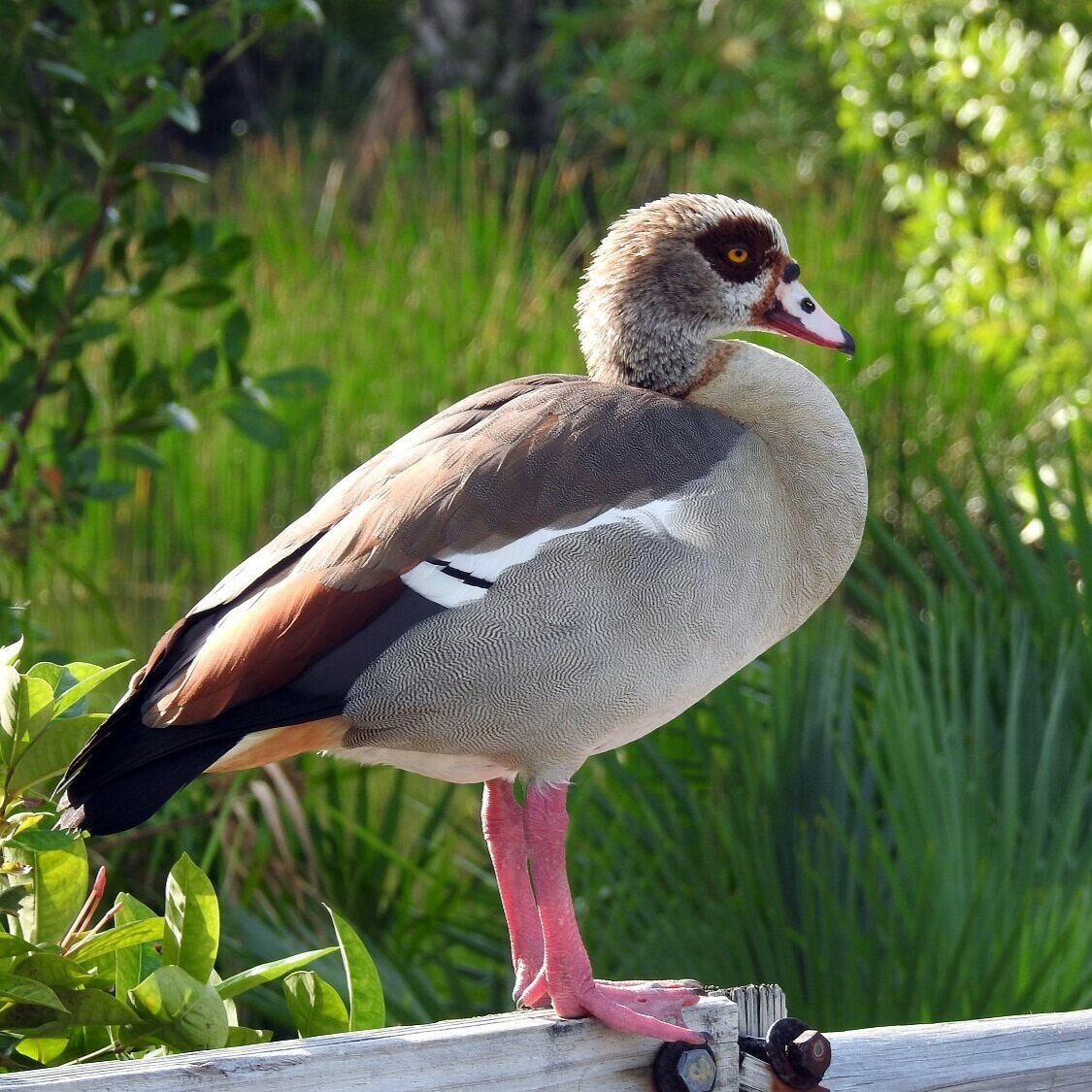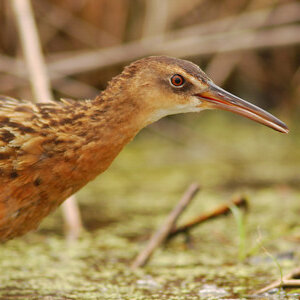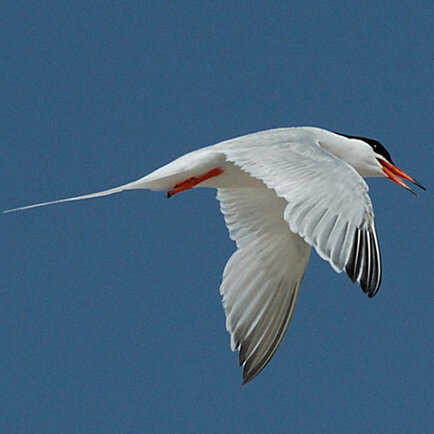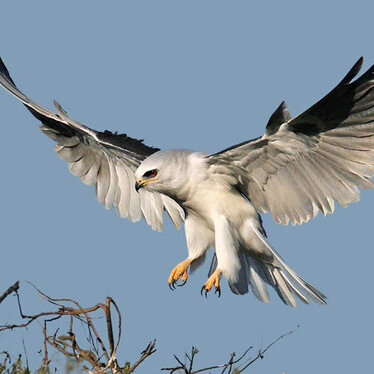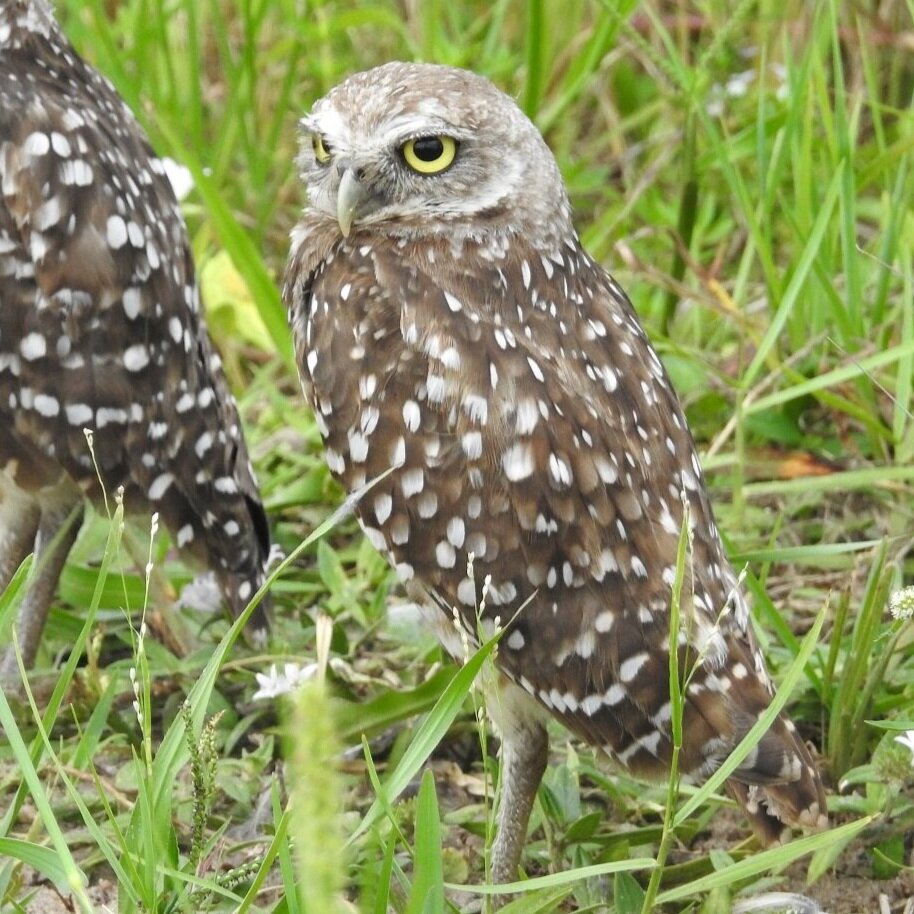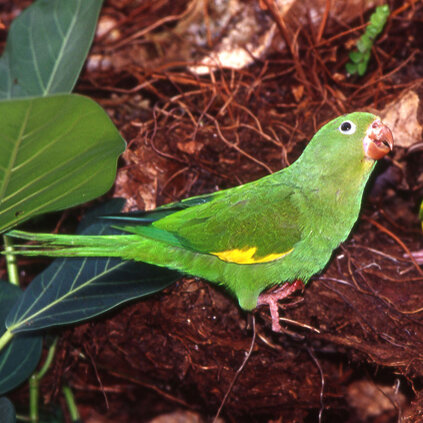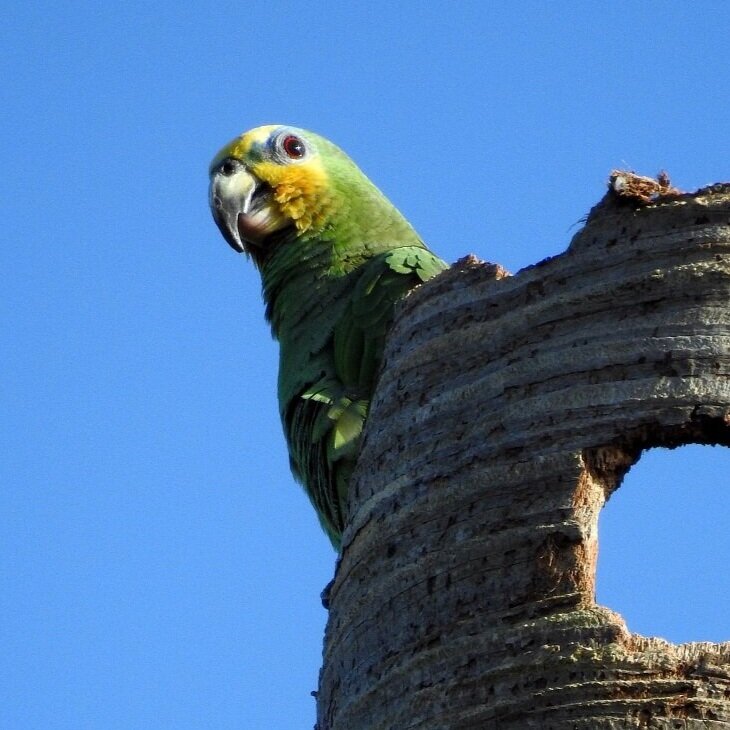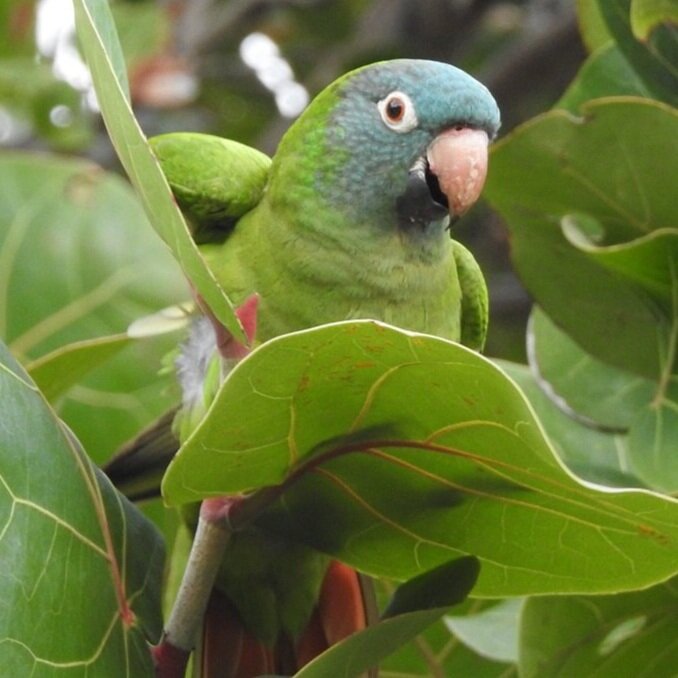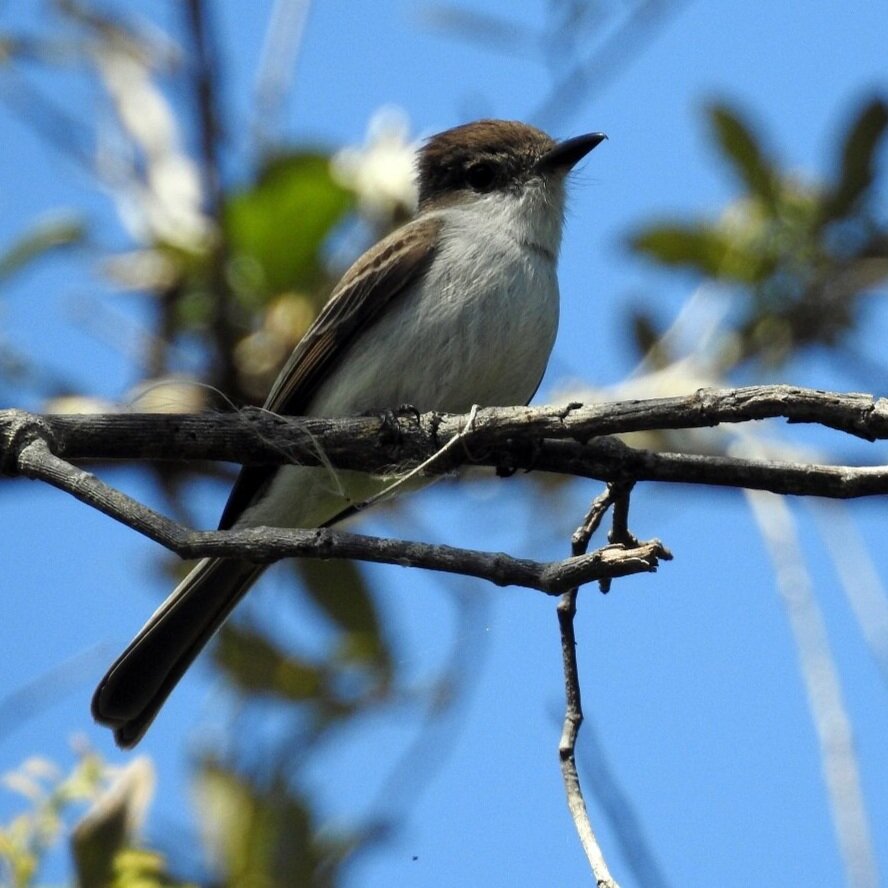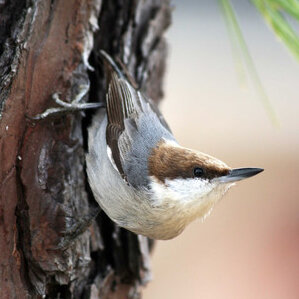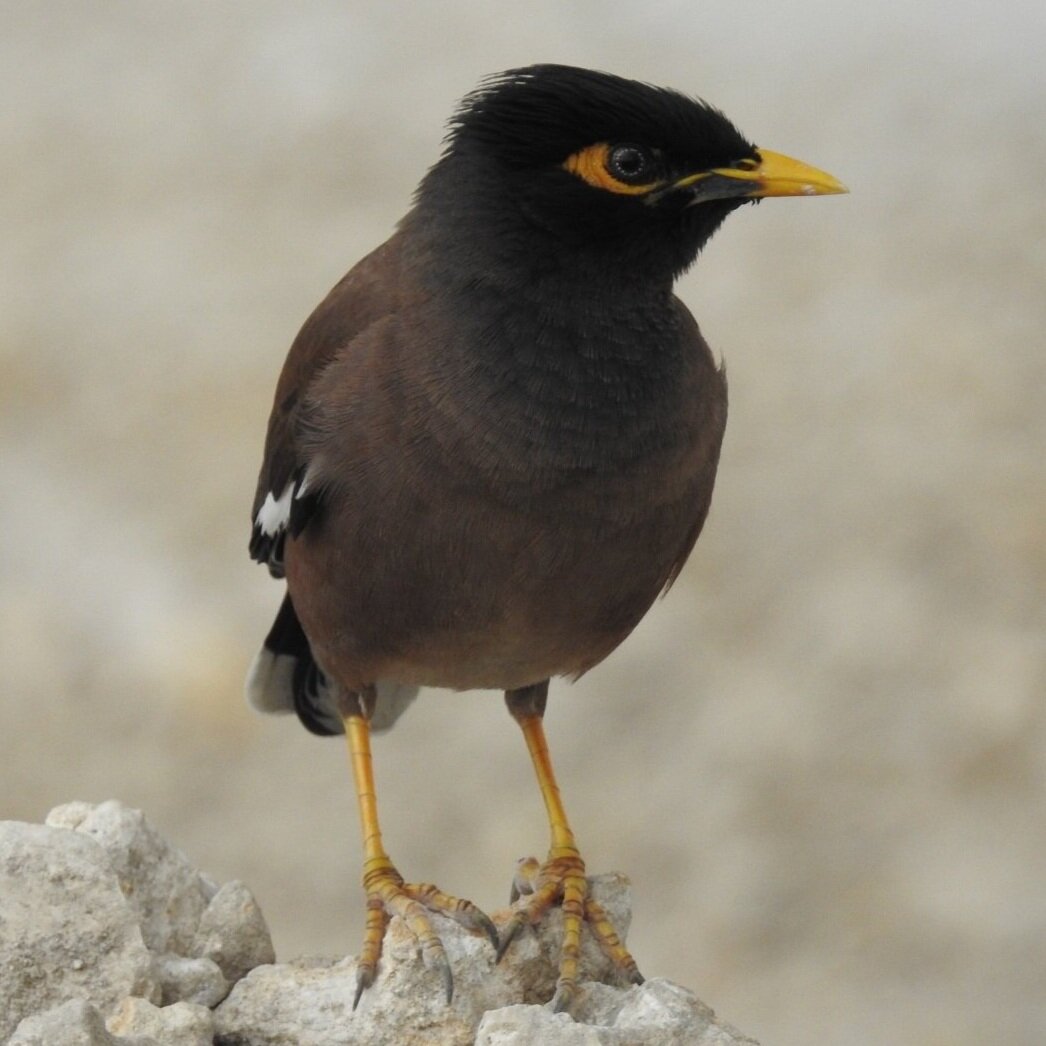- Ducks and Geese
- Flamingos
- Grebes
- Pigeons and Doves
- Cuckoos and Anis
- Nightjars
- Swifts
- Hummingbirds
- Rails
- Limpkin
- Plovers
- Gulls and Terns
- Tropicbirds
- Storks
- Frigatebirds
- Boobies
- Cormorants
- Herons
- Spoonbills
- Kites, Hawks and Eagles
- Owls
- Woodpeckers
- Falcons and Caracaras
- Parrots
- Flycatchers
- Vireos
- Jays and Crows
- Swallows
- Bulbuls
- Nuthatches
- Starlings and Mynas
- Thrushes
- Mimic Thrushes
- Waxbills
- Sparrows
- Spindalises
- Chats
- Blackbirds and Orioles
- New World Warblers
- Cardinals and Buntings
- Tanagers
South Florida Specialties
South Florida’s avifauna is a unique blend of species from temperate regions to the north and neotropical regions to the south, making our area a popular destination for visiting birders. This page provides locations where birders can search for many of our “specialty” birds, including introduced species and vagrants. Birds are listed according to the American Ornithological Society's Checklist taxonomy. Except for a few Caribbean vagrants and introduced parrots, each species has a ![]() link to a National Audubon Society reference. Some primarily neotropical birds such as Anhinga and White Ibis are so common in appropriate habitat that we don't list locations on this page.
link to a National Audubon Society reference. Some primarily neotropical birds such as Anhinga and White Ibis are so common in appropriate habitat that we don't list locations on this page.
Introduced Birds
South Florida’s avifauna includes an ever-growing list of parrots and other non-native species, many of which have become established in our area. Locations to search for many of these introduced species are included on this page. Species considered established and countable by the American Birding Association (ABA) include Egyptian Goose, Muscovy Duck, Indian Peafowl, Red Junglefowl, Rock Pigeon, Eurasian Collared-Dove, Gray-headed Swamphen, Monk Parakeet, Nanday Parakeet, Mitred Parakeet, Red-masked Parakeet, White-winged Parakeet, Yellow-chevroned Parakeet, Red-crowned Parrot, Rose-ringed Parakeet, Red-whiskered Bulbul, European Starling, Common Myna, Scaly-breasted Munia, House Sparrow and Spot-breasted Oriole. Some of these species are only ABA-countable in certain areas within south Florida. For details, see the ABA Area Introduced Species page.
Vagrant Birds
An amazing array of vagrant birds have shown up in south Florida over the years. Many of these species are native to the Bahamas or islands in the Caribbean, while others are from northern and western North America. A few have come from as far away as Mexico or Central and South America and even from Europe or Asia. Vagrant seabirds are sometimes found at coastal sea watch locations or during boat trips offshore. Though there are no guaranteed places to see these species, locations where many have been seen in the past are included on this page. If any have been sighted lately, they will be listed on the South Florida Rare Bird Update.
Some of the interesting Bahamian and Caribbean species seen in south Florida since 2000 include White-cheeked Pintail, Masked Duck, American Flamingo, Least Grebe, Ruddy Quail-Dove, Key West Quail-Dove, Zenaida Dove, Antillean Palm-Swift, Neotropic Cormorant, Stygian Owl, Short-eared Owl (Antillean race), Cuban Pewee, La Sagra's Flycatcher, Loggerhead Kingbird, Cuban Vireo, Thick-billed Vireo, Bahama Swallow, Bahama Mockingbird, Red-legged Thrush, Western Spindalis, Bananaquit, Yellow-faced Grassquit and Black-faced Grassquit. Additionally, species of uncertain origin such as Cuban Grassquit and Cuban Bullfinch have been occasionally found here.
Included in the long list of vagrant species from northern and western North America are Greater White-fronted Goose, Snow Goose, Brant, Cinnamon Teal, Common Eider, Long-tailed Duck, Eared Grebe, Broad-billed Hummingbird, Pacific Golden-Plover, Hudsonian Godwit, Surfbird, Purple Sandpiper, Baird’s Sandpiper, Heermann’s Gull, Iceland Gull, Glaucous Gull, Olive-sided Flycatcher, Yellow-bellied Flycatcher, Willow Flycatcher, Hammond’s Flycatcher, Say’s Phoebe, Ash-throated Flycatcher, Cassin’s Kingbird, Horned Lark, Violet-green Swallow, Mountain Bluebird, Bicknell’s Thrush, Northern Wheatear, Common Redpoll, Lapland Longspur, Smith’s Longspur, Harris’s Sparrow, Le Conte’s Sparrow, White-throated Sparrow, Dark-eyed Junco, Spotted Towhee, Bullock’s Oriole, Rusty Blackbird, MacGillivray’s Warbler, Kirtland’s Warbler, Black-throated Gray Warbler, Townsend’s Warbler, Hermit Warbler, Black-headed Grosbeak and Lazuli Bunting. Some northern and western species that were previously considered vagrants but have become annual or almost annual in south Florida in recent years include Rufous Hummingbird, Lesser Nighthawk, Alder Flycatcher, Brown-crested Flycatcher, Vermilion Flycatcher, Bell’s Vireo, Warbling Vireo, Lark Sparrow, Yellow-headed Blackbird and Western Tanager.
Species of primarily Mexican and Central and South American origin that have appeared in south Florida have included White-tipped Dove, Groove-billed Ani, Dark-billed Cuckoo, Buff-bellied Hummingbird, Large-billed Tern, Zone-tailed Hawk, Sulphur-bellied Flycatcher, Piratic Flycatcher, Variegated Flycatcher, Tropical Kingbird, Fork-tailed Flycatcher, Yellow-green Vireo, Tropical Mockingbird and Red-legged Honeycreeper. European and Asian vagrants have included Eurasian Wigeon, Bar-tailed Godwit, Ruff, Sharp-tailed Sandpiper, Red-necked Stint, Gray-tailed Tattler, Black-headed Gull, Slaty-backed Gull and European Robin, while vagrant seabirds have included South Polar Skua, Long-tailed Jaeger, Dovekie, Razorbill, Black-legged Kittiwake, Sabine’s Gull, Black Noddy, White-tailed Tropicbird, Red-billed Tropicbird, European Storm-Petrel, Fea’s Petrel, Black-capped Petrel, Manx Shearwater and Red-footed Booby.
Miami-Dade County Checklist
All of the ABA-countable birds that have been recorded within Miami-Dade County are listed here.
Where can I find . . .
Ducks and Geese
Black-bellied Whistling Duck
Fulvous Whistling-Duck
Egyptian Goose
This introduced species can be found along suburban canals and lakes, often with Muscovy Ducks and other introduced waterfowl. Reliable locations in Miami-Dade County include Crandon Gardens on Key Biscayne, Tropical Park, Baptist Hospital, Fairchild Tropical Botanic Gardens and Lake Laura (SW 137 Avenue/SW 82 Street in Kendale Lakes). In Broward County, try Plantation Preserve (7050 W Broward Blvd.), Tall Cypress Natural Area or Brian Piccolo Park. Photo: Luis Gonzalez/Tropical Audubon Society.
![]()
Mottled Duck
White-cheeked Pintail
White-cheeked Pintails are resident throughout much of the Caribbean, but are only occasionally seen in Florida. It's also difficult to determine if individuals are escapees or true vagrants. The most recent sightings in south Florida have been from Naples in 2020 and Virginia Key in 2017. Photo: Luis Gonzalez/Tropical Audubon Society.
![]()
Masked Duck
Masked Ducks are resident in scattered locations throughout the Caribbean, but are only occasionally seen in Florida. The most recent sighting in south Florida was from the Gate 15 area of Everglades National Park in 2010; others have been found recently at locations in central Florida. Photo: Larry Manfredi/Tropical Audubon Society.
![]()
Flamingos
American Flamingo
American Flamingos breed in scattered locations throughout the Caribbean (Yucatan, Cuba), but historically, they've only wintered in Florida, primarily in and around Florida Bay. Following the decimation of this wintering population by plume hunters in the early 1900s, flamingos were seen in Florida only occasionally. Beginning in the 1990s, small flocks, presumably wild birds, began to return to Florida Bay during winter, most often in the Snake Bight area, but flamingos remained rare and unpredictable elsewhere in the state. From 2014-18, a large flock appeared during spring in the Everglades Agricultural Area, especially at Stormwater Treatment Area-2 in Palm Beach County. The most recent invasion of flamingos, presumably from the Yucatan and primarily to the Gulf Coast, Florida Bay and the Keys, followed the passage of Hurricane Idalia in August, 2023.
A free-flying flock of American Flamingos, imported from Cuba in 1934, still resides in the infield lake at Hialeah Park racetrack. Though these birds breed at the racetrack, they are not considered wild birds.
Photo: Ursula Dubrick/Audubon Photography Awards.
![]()
Grebes
Least Grebe
Least Grebes are resident throughout the Caribbean, but are only occasionally seen in Florida. The first sighting was at Blue Hole in Key Deer National Wildlife Refuge in Monroe County in 1988. The most recent sighting was in 2021-22 at Crandon Park on Key Biscayne. Other recent sightings have been in Palm Beach County, including at Peaceful Waters Sanctuary and Green Cay Wetlands in 2019 and Yamato Scrub Natural Area in 2017. A pair of Least Grebes raised two chicks at this location in Fall, 2008. Photo: Luis Gonzalez/Tropical Audubon Society.
![]()
Pigeons and Doves
White-crowned Pigeon
White-crowned Pigeons are most common in the Florida Keys. Look for them at Key Largo Hammocks State Botanical Site, and in Key West. They may also be perched on wires anywhere along US 1 from Key Largo to Key West. They can often be seen in Everglades National Park, as well as in the Lucky Hammock area, just outside the park. Good areas within the park include Royal Palm Hammock, Paurotis and Nine Mile Ponds (scan the treetops on the far side of the ponds), and along Snake Bight Trail. Finally, they may be found in suburban south Miami-Dade. Check wires in South Miami and around Baptist Hospital, as well as at A.D. Barnes, Matheson Hammock and Kendall Indian Hammocks Parks. Photo: Luis Gonzalez/Tropical Audubon Society.
![]()
Ruddy Quail-Dove
Ruddy Quail-Doves are resident throughout the Caribbean (except the Bahamas), but are only occasionally seen in Florida. The most recent sighting was from Fort Zachary Taylor State Park in Key West in December 2020. Older sightings were from Bill Baggs Cape Florida State Park on Key Biscayne in 2013 and from Hugh Taylor Birch State Park in 2002. Photo: Luis Gonzalez/Tropical Audubon Society.
![]()
Key West Quail-Dove
Key West Quail-Doves are resident in the Bahamas, Cuba, Hispaniola and Puerto Rico, but are only occasionally seen in Florida. Recent sightings include from Dr. Von D. Mizell Eula Johnson/John U. Lloyd Beach State Park in Broward County in 2018 and 2019, and Lantana Nature Preserve in Palm Beach County, in 2018. Older sightings include at least two at Long Key State Park in the Middle Keys and another at the Deering Estate at Cutler in the fall/winter of 2014, Elliot Key, Biscayne National Park, in 2002, Hugh Taylor Birch State Park and Bill Baggs Cape Florida State Park, both in 1999. Photo: Larry Manfredi/Tropical Audubon Society.
![]()
Zenaida Dove
Zenaida Doves are resident throughout the Caribbean, but are only occasionally seen in Florida. The most recent sighting was from Long Key State Park in the Middle Keys in 2021-22. The last previous sighting was from West Kendall Agricultural Area in the summer of 2018 and again in 2019. Photo: Luis Gonzalez/Tropical Audubon Society.
![]()
Cuckoos and Anis
Smooth-billed Ani
In recent years, Smooth-billed Ani have been reported from a number of locations in south, central and even north Florida. These individuals are most likely vagrants from the Bahamas. This species has virtually disappeared as a breeding bird in Florida, though one recent sighting in 2015-16 was a pair that engaged in nest-building at Loxahatchee National Wildlife Refuge. Photo: Lorraine Minns/Audubon Photography Awards.
![]()
Mangrove Cuckoo
Black Point Park in Miami-Dade has been a reliable location for this secretive species, especially during spring. Other locations worth trying include Key Largo Hammocks State Botanical Site and Snake Bight and Bear Lake Trails in Everglades National Park. Photo: Paul Brooke/Audubon Photography Awards.
![]()
Nightjars
Lesser Nighthawk
Lesser Nighthawk winters in small numbers in south Florida, usually near canals or other bodies of water. Reliable locations include Dump Marsh and along the C-111 and L-31W canals outside the main entrance of Everglades National Park, as well as locations in the park such as Research Road and around Eco Pond in Flamingo. Photo: Bruno Struck/Audubon Photography Awards.
![]()
Antillean Nighthawk
Antillean Nighthawks can be found during spring and summer throughout the Florida Keys, but are most easily seen at dusk over large open areas such as on Grassy Key and at Marathon and Key West airports. Common Nighthawks are also likely at these locations, so learn to distinguish them by call ("pity-pit-pit" for Antillean, "peent" for Common). Photo: Luis Gonzalez/Tropical Audubon Society.
![]()
Chuck-will's-widow
Chuck-will's-widows are most likely to be seen during spring and fall migration, when they perch on tree limbs in hardwood hammocks and often flush when approached. Good locations during migration include A.D. Barnes Park and Bill Baggs Cape Florida State Park. During spring and summer, Chuck-will's-widows may be heard just before sunrise around pinelands and hammocks in Everglades National Park. Reliable locations include the pinelands around the entrance station and the Royal Palm Hammock parking area. Photo: Larry Manfredi/Tropical Audubon Society.
![]()
Swifts
Antillean Palm-Swift
Antillean Palm-Swift is a common resident in Cuba, Jamaica and Hispaniola, but a rare vagrant to Florida. The first record was of two individuals in Key West during the summer of 1972. It wasn't seen in Florida again until 2019, when one appeared in July on Grassy Key. Possibly the same individual was found in late September at Sombrero Key Golf Course in Marathon, where it remained until the end of December, 2019. Photo: Larry Manfredi/Tropical Audubon Society.
Hummingbirds
Bahama Woodstar
Bahama Woodstars are endemic to the Bahamas, but are very rarely seen in Florida. The most recent record was from Brevard County in May, 2017. The last verified sighting in south Florida was from Homestead in 1981. Photo: Lorraine Minns/Audubon Photography Awards.
Rails
Clapper Rail
King Rail
King Rails inhabit freshwater marshes and are more often heard than seen. Suitable habitat can be found at Shark Valley and around Anhinga Trail and Mahogany Hammock in Everglades National Park. They can also be found at Loxahatchee National Wildlife Refuge and in the Everglades Agricultural Area in Palm Beach County. Photo: Robert Gundy/Audubon Photography Awards.
![]()
Gray-headed Swamphen
This introduced species, formerly known as Purple Swamphen, is common at Stormwater Treatment Area 5 (STA-5) in Hendry County at Wakodahatchee and Green Cay Wetlands, and at STA1-E, STA1-W and Harold Campbell Day Use Area (STA3/4) in Palm Beach County. Swamphens can be found at several locations in Broward County, including Sawgrass Recreation Park on US 27, at Water Conservation Area 2-A, accessed from Markham Park in Weston, at Plantation Preserve on West Broward Boulevard in Plantation, at Tree Tops and Vista View Parks on Griffin Road in Davie and at Silver Lakes North Park and Chapel Trail Nature Preserve on Sheridan Street in Pembroke Pines. In Miami-Dade, swamphens can be found in wetlands on the south side of Dolphin Mall at Florida's Turnpike and the Dolphin Expressway (SR 836). Photo: Luis Gonzalez/Tropical Audubon Society.
![]()
Purple Gallinule
Look for Purple Gallinule at Anhinga Trail and at Shark Valley (especially in the canal along the west side of the loop road) in Everglades National Park, and at Wakodahatchee Wetlands, Green Cay Wetlands and Loxahatchee National Wildlife Refuge in Palm Beach County. Photo: Daniel Wakefield/Audubon Photography Awards.
![]()
Black Rail
Black Rails are rarely seen, but during winter, they can sometimes be heard at dawn or dusk near the end of Research Road, along the Coastal Prairie Trail in Flamingo, or along the main park road just south of the Mahogany Hammock turnoff, all in Everglades National Park. They have also been found in the Everglades Agricultural Area in Palm Beach County. Photo: Scott Bowers/Audubon Photography Awards.
![]()
Limpkin
Limpkin
Limpkins can reliably be found at Shark Valley, along Snake Road (CR 833) in Broward County and at Wakodahatchee Wetlands, Green Cay Wetlands, Wellington Environmental Preserve, and Loxahatchee National Wildlife Refuge in Palm Beach County. They are now regularly found along lakes and canals in many suburban areas in south Florida. They are often abundant at STAs in Palm Beach and Hendry Counties. Photo: Luis Gonzalez/Tropical Audubon Society.
![]()
Plovers
Snowy Plover
Wilson's Plover
Piping Plover
Wilson's Plovers are much more common on beaches on the Gulf Coast than on the Atlantic coast. Reliable locations in south Florida include Tigertail Beach on Marco Island (Collier County) and Big Carlos Pass and Bunche Beach, both near Ft. Myers Beach (Lee County). Photo: Luis Gonzalez/Tropical Audubon Society.
![]()
Gulls and Terns
Lesser Black-backed Gull
Brown Noddy
Black Noddy
Sooty Tern
Bridled Tern
Roseate Tern
Roseate Terns breed during summer in the Florida Keys. One location where they have nested in recent years is on the roof of the Government Center buildings, at mile marker 48.5 in Marathon. They may also be seen perched on channel markers in the Dry Tortugas. Photo: Larry Manfredi/Tropical Audubon Society.
![]()
Tropicbirds
White-tailed Tropicbird
White-tailed Tropicbirds breed throughout the Caribbean, but are only rarely seen in Florida. Most sightings have been from the Dry Tortugas. Both White-tailed and Red-billed Tropicbirds are occasionally seen on pelagic trips off the eastern coast of south Florida. Photo: Daniel Gribbin/Audubon Photography Awards.
![]()
Storks
Wood Stork
Wood Storks nest at Paurotis Pond in Everglades National Park, but can often be found during winter at Anhinga Trail, Mrazek Pond, Shark Valley and other locations within the National Park. It is also not unusual to see them feeding in wet areas along highways. During late summer, they often congregate in large numbers in the Everglades Agricultural Area in Palm Beach County. Photo: Luis Gonzalez/Tropical Audubon Society.
![]()
Frigatebirds
Magnificent Frigatebird
Magnificent Frigatebirds are most common during summer in the Florida peninsula and are easy to see on Key Biscayne. They roost on an island off Crandon Marina, to your right after you cross the Bear Cut Bridge onto Key Biscayne. They may be seen year-round in the Florida Keys and the Dry Tortugas. Photo: David Yellen/Audubon Photography Awards.
![]()
Boobies
Masked Booby
Brown Booby
Brown Boobies often perch on navigational light towers off the Florida Keys, including Molasses Reef Light off Key Largo, visited daily during the glass-bottom boat tour at John Pennekamp State Park. They often perch on Fowey Light, in Biscayne National Park; a boat is needed to reach this location. They can sometimes be seen on channel markers in the Dry Tortugas. Photo: Jared Katz/Audubon Photography Awards.
![]()
Red-footed Booby
Cormorants
Neotropic Cormorant
Neotropic Cormorants are resident in the Bahamas and Cuba. The first verified sighting in Florida was from Boca Chica Beach, near Key West, in 2007. Others were found there in 2009 and 2014 through 2016. Since 2012, Neotropic Cormorants have been found during winter at Wakodahatchee Wetlands in Palm Beach County; one or two have been seen on nests. They are now being reported at other Palm Beach locations, including Green Cay Wetlands, Loxahatchee NWR and at Peaceful Waters Sanctuary in Wellington. One was reported at Topeekeegee Yugnee Park in Broward from 2015-2017, another from Crandon Park on Key Biscayne in 2019. Photo: Luis Gonzalez/Tropical Audubon Society.
![]()
Herons
Least Bittern
Reddish Egret
Spoonbills
Roseate Spoonbill
Kites, Hawks and Eagles
White-tailed Kite
White-tailed Kites are occasionally seen in Southwest Miami-Dade. Places to check include over fields around Lucky Hammock on Aerojet Road and the C-357 sparrow fields on SW 168 Street in the East Everglades. In the main portion of the national park they are most often found in the restoration area at the end of Research Road. They seem to prefer prairie-like areas, including some farm fields. Photo: Cleve Nash/Audubon Photography Awards.
![]()
Swallow-tailed Kite
These beautiful raptors arrive in Florida in late February and return to their wintering grounds in South and Central America by September. Look for them anywhere along the main park road in Everglades National Park, as well as at Royal Palm Hammock, Long Pine Key, Paurotis Pond, West Lake and the Flamingo area. They may also be seen along Tamiami Trail in Big Cypress National Preserve, at Corkscrew Swamp Sanctuary in Naples and even in suburban Miami-Dade, especially the South Miami area. Photo: James Gray/Audubon Photography Awards.
![]()
Snail Kite
Throughout the year but especially during winter, Snail Kites can be found on U.S. 41 (Tamiami Trail) near the Shark Valley section of Everglades National Park. Good vantage points are along the L-67 Canal east of Shark Valley, the parking lot of the Miccosukee Indian Restaurant (across from the Shark Valley entrance), and the airboat concession just across the road from the Everglades Tower Motel, a mile west of Shark Valley. Snail Kites can also be found in the Water Conservation Area west of Markham Park in Broward County, at Loxahatchee National Wildlife Refuge in Palm Beach County. They can be common at Stormwater Treatment Area 5 (STA-5) in Hendry County and STA-1E in Palm Beach County. Photo: Allen Hoffacker/Audubon Photography Awards.
![]()
Bald Eagle
Great Black-Hawk
Although not ABA-countable, Great Black-Hawks of unknown origin have been seen in the Miami area since the 1970's. In recent years, most sightings have been on Virginia Key. Robin Diaz has provided a detailed summary of the situation. Photo: Larry Manfredi/Tropical Audubon Society.
Short-tailed Hawk
During winter, Short-tailed Hawks can be most reliably seen in Everglades National Park. They are seen regularly over Royal Palm Hammock (watch for them among kettles of vultures), along Research Road, at West Lake, Nine Mile Pond and Eco Pond in Flamingo. They can also be seen over suburban Miami-Dade parks. Photo: Luis Gonzalez/Tropical Audubon Society.
![]()
Owls
Burrowing Owl
Burrowing Owls reside at a number of local airports, including Kendall/Tamiami Executive Airport (SW 137 Avenue, between SW 120 and SW 136 Street), Homestead General Aviation Airport (SW 217 Avenue, north of SW 296 Street), Opa-Locka Airport (NW 135 Street, between NW37 and NW 57 Avenue) and Ft. Lauderdale Executive Airport (NW 21 Avenue, north of Commercial Boulevard). Burrowing Owls can also be found at Brian Piccolo Park, on Sheridan Street in Cooper City (Broward County), at Florida Atlantic University in Boca Raton (Palm Beach County), on golf courses and in residential areas in Marathon (Monroe County), on Marco Island (Collier County) and in Cape Coral (Lee County). Burrows at all of these locations are usually marked with stakes, orange cones or t-bars. Photo: Luis Gonzalez/Tropical Audubon Society.
![]()
“Arawak” (Short-eared) Owl
The Arawak Owl is the Antillean race of Short-eared Owl. It is resident in Cuba and Hispaniola and is an almost annual visitor to the Dry Tortugas. Individuals are sometimes found at Ft. Zachary Taylor State Park in Key West. The Antillean race is buffier than the continental race, itself an occasional winter visitor to the Florida mainland. Photo: Larry Manfredi/Tropical Audubon Society.
Woodpeckers
Red-cockaded Woodpecker
Red-cockaded Woodpeckers nest in Big Cypress National Preserve as well as in J W Corbett Wildlife Management Area in Palm Beach County, but in locations inaccessible to birders or heavily used by hunters. This species has been recently introduced to Jonathan Dickinson State Park in Martin County and DuPuis Management Area in Martin and Palm Beach Counties; accessible nest clusters can be found along the management area's auto tour road. In southwest Florida, they have been recently introduced at Picayune Strand State Forest in Collier County; access is via the Belle Mead Horse Trail. They also nest at Babcock Webb Wildlife Management Area, in Charlotte County. Photo: Luis Gonzalez/Tropical Audubon Society.
![]()
Falcons and Caracaras
Crested Caracara
Parrots
Over 75 species of parrots have been recorded in urban and suburban Florida; of these, at least 20 species have bred in the state. Eight of our parrots are currently ABA-countable: Monk and Nanday Parakeet (statewide), White-winged, Yellow-chevroned, Mitred and Red-masked Parakeet (Miami region), Red-crowned Parrot (Ft. Lauderdale and Palm Beach region) and Rose-ringed Parakeet (Naples region).
Note: White-winged Parakeet (Brotogeris versicolurus) and Yellow-chevroned Parakeet (Brotogeris chiriri) were once considered the same species; Canary-winged Parakeet. This species was split in 1997.
The most reliable way to locate parrots in residential neighborhoods is by driving side streets with the windows down, listening for squawking. Early morning and late afternoon are most productive. As always when birding in urban areas, common sense is essential. Avoid birding alone. Lock car doors and secure valuables out of sight. Do not trespass on private property.
Monk Parakeet
While parrots introduced to Florida typically nest in tree cavities, Monk Parakeets are the only species that builds communal stick nests. These large, bulky nests can be found throughout suburban southeast Florida, sometimes in trees but also on power poles and other man-made structures. Reliable locations in Miami-Dade include Miami Shores, Miami Springs (around the Fair Haven Nursing Home), Key Biscayne, Baptist Hospital and Kendall Indian Hammocks, A D Barnes, Pine Woods and Matheson Hammock Parks. The parakeets are often found around shopping centers along SW 88 Street (Kendall Drive); stick nests are conspicuous on power poles where North Kendall Drive crosses SW 127 Avenue. In Broward County, try Everglades Holiday Park on US 27 at the western end of Griffin Road and Topeekeegee Yugnee Park in Hollywood. Photo: Gary Clark/Audubon Photography Awards.
![]()
White-winged Parakeet
This diminutive parakeet is distinguished from Yellow-chevroned Parakeet by the white secondary and inner primary feathers in their wings and their grayish-blue head. Currently, the most reliable location for this species is on the grounds of the Biltmore Hotel in Coral Gables. They have also been found at the Ocean Bank building on LeJeune Road and NW 7 Avenue in Miami, around the Miami Shores golf course and at Plantation Preserve in Broward County. Photo: Larry Manfredi/Tropical Audubon Society.
![]()
Yellow-chevroned Parakeet
This species is distinguished from White-winged Parakeet by the lack of white secondary and inner primary feathers in their wings. Yellow-chevroned Parakeets are most often seen in Miami Springs, Coral Gables, South Miami and Kendall. Reliable locations include Matheson Hammock, A D Barnes and Pine Woods Parks as well as the University of Miami campus and Granada golf course in Coral Gables. Photo: Larry Manfredi/Tropical Audubon Society.
![]()
Nanday Parakeet
In southeast Florida, Nanday Parakeets (formally known as Black-hooded Parakeets) are most often seen in Broward and Palm Beach Counties. Reliable locations in Broward include Tall Cypress Natural Area, along US 1 near Ft Lauderdale International Airport and around the IGFA Fishing Hall of Fame on Griffin Road, just west of I-95. Boynton Inlet in Boynton Beach is a reliable location in Palm Beach. Nandays can sometimes be found in Miami-Dade neighborhoods, including Biscayne Gardens, Miami Shores and the Falls and Zoo Miami areas. Nandays are common in the Tampa/St. Petersburg area. Photo: Luis Gonzalez/Tropical Audubon Society.
![]()
Budgerigar
“Budgies," native to Australia, once numbered in the thousands on Florida’s west coast. They have since become extirpated from the state. Any individuals encountered will be escapees. Photo: Larry Manfredi/Tropical Audubon Society.
Red-crowned Parrot
This Amazona parrot seems to have disappeared from Miami-Dade County, but can still be found in Broward and Palm Beach Counties. In Broward, try around Richardson Park in Wilton Manors. In Palm Beach, large flocks can often be found around the Breakers golf course and Henry Flagler museum in the city of Palm Beach. Photo: Larry Manfredi/Tropical Audubon Society.
![]()
Lilac-crowned Parrot
Orange-winged Parrot
This is the most common Amazona parrot in Miami-Dade County; flocks can also be found in Broward County. They inhabit several county parks in Miami-Dade, including Greynolds Park in North Miami Beach and Matheson Hammock Park in Coral Gables. They are also found around the golf courses and surrounding neighborhoods in Miami Shores and Miami Springs, on the University of Miami campus in Coral Gables and around Brewer Park in South Miami. In Broward, look for them at Plantation Preserve. Photo: Luis Gonzalez/Tropical Audubon Society.
Blue-and-yellow Macaw
This spectacular macaw is most often seen in Coral Gables, in particular around the University of Miami campus and at Matheson Hammock Park. They are also seen often at A D Barnes Park. Photo: Luis Gonzalez/Tropical Audubon Society.
Chestnut-fronted Macaw
This small macaw is most common in the Miami Shores area, but can also be reliably found around Brewer Park in South Miami and Matheson Hammock Park in Coral Gables. Photo: Luis Gonzalez/Tropical Audubon Society.
Blue-crowned Parakeet
This distinctive parakeet can be found at Greynolds Park in North Miami Beach, around Enchanted Forest and Arch Creek Parks in Miami Shores, on Miami Beach, especially in the South Beach area and on Key Biscayne. In Broward County, look for them at Topeekeegee Yugnee Park in Hollywood, Evergreen Cemetery in Fort Lauderdale and Richardson Park in Wilton Manors. Photo: Luis Gonzalez/Tropical Audubon Society.
![]()
Green Parakeet
Crimson-fronted Parakeet
The second of three often-misidentified parakeets, reliably found only in the Miami Springs area, usually in mixed-species flocks. This parakeet is smaller than a Green Parakeet, with a red forecrown (not extending behind the eye), red and yellow in the underwing and red in the bend of the wing. Photo: Kevin Malo/Audubon Photography Awards.
Scarlet-fronted Parakeet
The third of three often-misidentified parakeets, reliably found only in the Miami Springs area, usually in mixed-species flocks. In 2023, this parakeet was split into two species: Scarlet-fronted (native to Colombia and Venezuela) and Cordilleran (native to Ecuador and Peru). It's currently unknown which of these two species are present in Miami. Both species are larger than a Green Parakeet, with a red crown (extending behind the eye) and no red or yellow in the underwing. Some individuals may have red in the bend of the wing. Photo: Larry Manfredi/Tropical Audubon Society.
Mitred Parakeet
Larger than any of the aforementioned parakeets, mostly green but with splotchy red in the face and scattered red feathers elsewhere on the body, this parakeet is widespread in Miami-Dade and Broward Counties. Reliable locations in Miami-Dade include the Baptist Hospital and Dadeland areas in Kendall. They can also be found in Miami Shores, on Miami Beach and in Miami Springs. Reliable locations in Broward include Plantation Preserve, Evergreen Cemetery in Fort Lauderdale and Richardson Park in Wilton Manors. Photo: Luis Gonzalez/Tropical Audubon Society.
![]()
Red-masked Parakeet
Smaller than Mitred, with a bright red head as well as red in the underwing and in the bend of the wing, this parakeet is also widespread in Miami-Dade and Broward Counties. Reliable locations in Miami-Dade include the Biltmore hotel and golf course, the University of Miami campus and Matheson Hammock Park, all in Coral Gables. They can also be found in South Miami, Miami Shores, on Miami Beach and in Miami Springs Reliable locations in Broward include Topeekeegee Yugnee Park in Hollywood, Evergreen Cemetery in Fort Lauderdale and Richardson Park in Wilton Manors. Photo: Ben Knoot/Audubon Photography Awards.
![]()
White-eyed Parakeet
Smaller than Mitred, mostly green with scattered red feathers and with red and yellow in the underwing and red in the bend of the wing, this parakeet is also widespread in Miami-Dade and Broward Counties. Reliable locations in Miami-Dade include Miami Shores, Miami Beach and Key Biscayne. Reliable locations in Broward include Topeekeegee Yugnee Park in Hollywood and Richardson Park in Wilton Manors. Photo: Larry Manfredi/Tropical Audubon Society.
Flycatchers
Cuban Pewee
Cuban Pewees, sometimes called Crescent-eyed Pewees, are resident in the Bahamas and Cuba, but there are only a few records in Florida. The most recent sighting was from Crandon Park on Key Biscayne in spring, 2023. Older sightings were from Blue Hole on Big Pine Key during 2020-2021, Bill Baggs Cape Florida State Park on Key Biscayne in 2017, Crandon Park on Key Biscayne in 2016 and Long Pine Key in Everglades National Park in 2010. Photo: Luis Gonzalez/Tropical Audubon Society.
![]()
Alder Flycatcher
Vermilion Flycatcher
Vermilion Flycatchers now winter almost annually in Florida. The most recent south Florida sighting was in winter 2022-23, at the water control structure at the C-111 canal where it crosses SR 9336, about a mile east of the main entrance to Everglades National Park. Photo: Alecia Smith/Audubon Photography Awards.
![]()
Brown-crested Flycatcher
A few Brown-crested Flycatchers are seen annually during winter. The best locations to find them are in and around Everglades National Park , along Aerojet Road and along the C11E canal, about 2.5 miles east of the park entrance. Listen for their loud “whit” call. Keep in mind that they are substantially outnumbered by Great Crested Flycatchers. Photo: Larry Manfredi/Tropical Audubon Society.
![]()
La Sagra's Flycatcher
La Sagra's Flycatchers are resident in the Bahamas and Cuba, but are seen in Florida almost annually, typically at coastal locations such as on Key Biscayne and Key Largo but sometimes at inland locations such as A.D. Barnes Park in Miami and in Everglades National Park. Photo: Luis Gonzalez/Tropical Audubon Society.
![]()
Tropical Kingbird
Tropical Kingbirds now winter almost annually in south Florida. Recent locations include along SR 9336 outside Everglades National Park, at the S-334 Water Control Structure west of Krome Avenue on Tamiami Trail and at STAs in Palm Beach and Hendry Counties. Photo: Luis Gonzalez/Tropical Audubon Society.
![]()
Gray Kingbird
Gray Kingbirds are common and conspicuous during spring and summer in suburban Miami and throughout the Keys; they can usually be found around shopping centers. Bill Baggs Cape Florida State Park on Key Biscayne is another reliable location; they often perch on wires near the lighthouse. Photo: Luis Gonzalez/Tropical Audubon Society.
![]()
Loggerhead Kingbird
Loggerhead Kingbirds are resident in the Bahamas, Cuba, Hispaniola and Puerto Rico. The first verified sighting in Florida was from Fort Zachary Taylor State Park in 2007, with a repeat visit in 2009. The most recent sighting was at Bill Baggs Cape Florida State Park on Key Biscayne in December, 2017. Photo: Larry Manfredi/Tropical Audubon Society.
![]()
Scissor-tailed Flycatcher
Scissor-tailed Flycatchers, along with Western Kingbirds, can often be found in Flamingo, Everglades National Park, during winter. Check along the main park road from the visitor center to Eco Pond. Near the park entrance, check the wires and fences along SR 9336 and around Lucky Hammock on Aerojet Road. Photo: Luis Gonzalez/Tropical Audubon Society.
![]()
Vireos
Thick-billed Vireo
Thick-billed Vireos are resident in the Bahamas, but are now appearing almost annually in Florida, typically in coastal areas. Recent sightings from Long Key State Park in Monroe County include juvenile birds, suggesting possible breeding in the Keys. Other recent sightings include from Crandon Park and R. Hardy Matheson Preserve in Miami-Dade County and John D. MacArthur Beach State Park in Palm Beach County. Photo: Luis Gonzalez/Tropical Audubon Society.
![]()
Bell's Vireo
Black-whiskered Vireo
During spring and summer, Black-whiskered Vireos are easiest to find in the Florida Keys, where they sing incessantly throughout the day. Good locations include Key Largo Hammocks State Botanical Site and Long Key State Park. During spring migration, Black-whiskered Vireos are often seen and heard at Bill Baggs Cape Florida State Park, Matheson Hammock Park and in hammocks throughout Everglades National Park. Photo: Larry Manfredi/Tropical Audubon Society.
![]()
Jays and Crows
Florida Scrub-Jay
Swallows
Bahama Swallow
Bahama Swallows are endemic to the Bahamas, but are very rarely seen in Florida. In the fall of 2020, several were seen at Curry Hammock State Park and in Marathon in the Middle Keys. The previous sightings were from the fall of 2014, also in the Middle Keys; another was seen at Bill Baggs Cape Florida State Park on Key Biscayne. Photo: Larry Manfredi/Tropical Audubon Society.
Cave Swallow
At dawn and dusk during spring and summer, look for Cave Swallows of the West Indian race under Florida Turnpike bridges, such as at the Portofino Plaza shopping center on Campbell Drive in Homestead, over Black Creek, just north of Southwest 216th Street in Cutler Bay and under a bridge over Snapper Creek at SW 107 Avenue just north of Sunset Drive (SW 72 Street) in Kendall; they may be also seen collecting mud for nests or feeding at Cutler Wetlands and Dump Marsh. Photo: Luis Gonzalez/Tropical Audubon Society.
![]()
Bulbuls
Red-whiskered Bulbul
Red-whiskered Bulbuls are often seen in the neighborhoods around Baptist Hospital on SW 88 Street (Kendall Drive), including the Kendallwood neighborhood on SW 82 Street, west of SW 87 Avenue, around Kenwood Elementary (SW 79 Avenue, 0.2 miles south of Kendall Drive) and in the Kings Creek area north of Kendall Drive and west of the Palmetto Expressway. They can also be reliably found at Pine Woods Park, on SW 102 Avenue and SW 132 Street. Photo: Luis Gonzalez/Tropical Audubon Society.
![]()
Nuthatches
Brown-headed Nuthatch
Starlings and Mynas
Common Hill Myna
This arboreal myna has become difficult to find in recent years; they prefer tropical hardwood hammocks but can also be found in suburban neighborhoods in southern Miami Dade. Look for them at Matheson Hammock Park and adjacent Fairchild Tropical Botanic Garden, around Baptist Hospital on North Kendall Drive, and in the Falls and Zoo Miami areas. Photo: Luis Gonzalez/Tropical Audubon Society.
Common Myna
Thrushes
Red-legged Thrush
Red-legged Thrush are resident throughout much of the Caribbean, but have been recorded in Florida on only four occasions. The most recent sightings have been from Key West Tropical Forest and Botanical Gardens during winter of 2020-2021, and from Lantana Nature Preserve in Palm Beach County and South Pointe Park on Miami Beach, both in 2019. Photo: Luis Gonzalez/Tropical Audubon Society.
Mimic Thrushes
Bahama Mockingbird
Bahama Mockingbirds are resident in the Bahamas, Jamaica and on islands off the northern coast of Cuba, but are seen almost annually in Florida, typically at coastal locations. Recent sightings include Crandon Park and Bill Baggs Cape Florida State Park on Key Biscayne in 2022, Spanish River Park in Boca Raton in 2022 and 2021 and Black Point Park in Miami-Dade in 2021. Photo: Luis Gonzalez/Tropical Audubon Society.
![]()
Waxbills
Scaly-breasted Munia
Scaly-breasted Munias, formerly known as Nutmeg Mannikins, can be found in weedy, overgrown areas in Miami-Dade County, primarily in the Cutler Bay area. Munias are now regularly visiting seed feeders at the Deering Estate at Cutler visitor center. A large flock inhabits Pine Woods Park, on SW 102 Avenue and SW 132 Street in the Falls area of south Miami-Dade. They are occasionally seen in weedy areas on the west side of Matheson Hammock Park. Photo: Lou Orr/Great Backyard Bird Count.
![]()
Sparrows
Bachman's Sparrow
Bachman's Sparrows are year-round residents of pinelands with a saw palmetto understory, but are easiest to find when males are singing. At Jonathan Dickinson State Park in Martin County, they can be reliably found in pine flatwoods around the Kitching Creek Trail, located near the picnic area at the west end of the park road. Other locations where this sparrow can be found include J. W. Corbett Wildlife Management Area in Palm Beach County and Babcock-Webb Wildlife Management Area in Charlotte County. Photo: Larry Manfredi/Tropical Audubon Society.
![]()
Seaside Sparrow
The Cape Sable race of Seaside Sparrow, once considered a separate species, is most easily found during the breeding season (late winter/early spring), when they are singing. The most reliable location is in Everglades National Park, in sawgrass prairie beginning about 0.5 mile past the Mahogany Hammock turnoff.
![]()
Nelson’s Sparrow
Nelson's Sparrow can be found during winter in healthy (not damaged by a recent hurricane) coastal prairie habitat around Flamingo, in Everglades National Park. They are most often found on the Coastal Prairie Trail, which starts at the west end of the Flamingo campground, or occasionally in coastal prairie habitat behind Eco Pond. They can also be found during winter in salt marsh habitat at Bunche Beach Preserve and at Winkler Point in Estero Bay Preserve State Park in Ft. Myers. Photo: Roberto Torres/Tropical Audubon Society.
![]()
Saltmarsh Sparrow
Saltmarsh Sparrow can occasionally be found during winter in healthy (not damaged by a recent hurricane) coastal prairie habitat around Flamingo, in Everglades National Park. They are very similar in appearance to Nelson's Sparrow (they were once considered the same species, called Sharp-tailed Sparrow) and are usually found by closely examining every bird when a flock of Nelson's Sparrow is located. Look for these flocks on the Coastal Prairie Trail, which starts at the west end of the Flamingo campground, or in coastal prairie habitat behind Eco Pond. They can also be found during winter in salt marsh habitat at Bunche Beach Preserve and at Winkler Point in Estero Bay Preserve State Park in Ft. Myers.Photo: Frank Lehman/Audubon Photography Awards.
![]()
Spindalises
Western Spindalis
Western Spindalis are resident in the Bahamas and Cuba, but are seen almost annually in Florida, typically at coastal locations. In 2009, a pair successfully nested at Long Pine Key in Everglades National Park, the first North American breeding record for this species. Another pair was found in this area in 2017. Photo: Camilla Cerea/Audubon.
![]()
Chats
Yellow-breasted Chat
Blackbirds and Orioles
Yellow-headed Blackbird
Spot-breasted Oriole
Spot-Breasted Orioles can be found throughout the suburbs of southeastern Florida, most often in areas with exotic flowering trees. Check neighborhoods in Biscayne Gardens, Miami Shores, Miami Springs, South Miami and around Baptist Hospital on Kendall Drive. The oriole has also been found at A.D. Barnes, Kendall Indian Hammock, Westwind Lakes and Bill Sadowski Parks in Miami-Dade and in Evergreen Cemetery and Markham Park in Broward. Photo: Luis Gonzalez/Tropical Audubon Society.
![]()
Shiny Cowbird
Shiny Cowbirds can sometimes be found during spring and summer among flocks of Brown-headed Cowbirds, feeding in grassy areas around the Flamingo Visitor Center parking lots in Everglades National Park. They also come to seed feeders in the Homestead area. Photo: Larry Manfredi/Tropical Audubon Society.
![]()
Bronzed Cowbird
Bronzed Cowbirds, which have recently become regular denizens of south Florida, have been regularly seen at a shopping center on Bird Road (SW 40 Street) and SW 87 Avenue in Miami, in Hialeah, the West Kendall Agricultural Area, in Homestead, around Flamingo in Everglades National Park and at Eagle Lakes Park in Naples. Check any cowbird flock you see for both Bronzed and Shiny Cowbirds. Photo: Luis Gonzalez/Tropical Audubon Society.
![]()
New World Warblers
Prothonotary Warbler
Prothonotary Warblers are at the southern end of their breeding range in south Florida. Here they breed in cypress swamps such as those in Big Cypress National Preserve. A reliable location is at Sweetwater Strand, on Loop Road in Big Cypress. Migrants can show up anywhere. Photo: Gary Robinette/Audubon Photography Awards.
![]()
Cuban Golden (Yellow) Warbler
This West Indian subspecies of the Yellow Warbler breeds in mangrove forests in the Keys and Everglades National Park. A reliable location is around the Card Sound Bridge tollbooth on Card Sound Road; the bridge connects Key Largo to the mainland. Photo: Larry Manfredi/Tropical Audubon Society.
Cardinals and Buntings
Painted Bunting
Painted Buntings come to feeders during winter at Castellow Hammock and Bill Sadowski Parks in Miami Dade, as well as Green Cay Wetlands and Okeeheelee Nature Center in Palm Beach. Also look for Painted Buntings in brushy areas around Lucky Hammock and the Annex in Southern Glades WEA, and along Snake Bight and Coastal Prairie Trails in Everglades National Park. Photo: Larry Smith/Audubon Photography Awards.
![]()
Tanagers
Bananaquit
The Bananaquit is easy to find in the Bahamas. In South Florida, it is an occasional visitor during fall, winter, and spring. It is most likely to show up in the Keys or within a few miles of the coast. Recent sightings have been at Bill Baggs Cape Florida State Park and Crandon Park on Key Biscayne, A.D. Barnes Park in Miami, North Shore Open Space Park on Miami Beach and Richardson Park in Broward County. Photo: Luis Gonzalez/Tropical Audubon Society.
![]()
Yellow-faced Grassquit
Yellow-faced Grassquits are resident in Cuba, Hispaniola, Puerto Rico and Jamaica, but are rarely seen in Florida. The most recent sighting was from Long Key State Park in 2022. Older sightings were from Fort Zachary Tayler in Key West in 2009, the Dry Tortugas in 2002 and Eco Pond in Everglades National Park in 2001. Photo: Larry Manfredi/Tropical Audubon Society.
Black-faced Grassquit
Black-faced Grassquits are resident throughout the Caribbean (though rare and local in Cuba) and in recent years have become annual vagrants to Florida, especially in the Keys. The most recent sightings have been from Ft. Zachary Taylor State Park in Key West in 2021-22 and 2019, Blue Hole on Big Pine Key from 2019 to 2021, Everglades National Park and John Pennekamp State Park on Key Largo in 2020 and Bill Baggs Cape Florida State Park on Key Biscayne in 2018. Photo: Luis Gonzalez/Tropical Audubon Society.
![]()
References
Herbert Raffaele et al., “A Guide to the Birds of the West Indies,” Princeton University Press, 1998.
William B. Robertson, Jr. and Glen E. Woolfenden, “Florida Bird Species: An Annotated List,” Florida Ornithological Society, 1992.
Henry M. Stevenson and Bruce H. Anderson, “The Birdlife of Florida,” University Press of Florida, 1994
Need More Info?
A variety of birding and nature books are available on amazon.com, including Brian Rapoza's Birding Florida, which covers many birding locations throughout the state.
Banner photo: American Bittern by Sean Leahy


